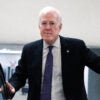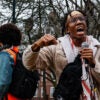The top practitioners of critical race theory just held a weeklong “summer school” in Nashville, Tennessee, to strategize, assess the movement, and debate how best to proselytize the next generation. It was an instructive six days of revolutionary agitprop.
Two things immediately stood out. The first is that, yes, despite its protestations to the contrary, the architects of CRT know they must focus intently on those who participate in the teaching profession. If CRT is a tool to be used for “revolutionizing a culture,” as its intellectual godfather, Derrick Bell, once put it, it must be implemented by teachers starting in K-12 and through graduate school.
K-12 teachers, along with students at all levels, were given special ticket prices to the CRT conference at a deep discount, as my colleague and friend Jonathan Butcher pointed out. K-12 principals also were given a special package, though at a smaller discount.
The Daily Signal depends on the support of readers like you. Donate now
The other unmistakable takeaway is that CRT practitioners are aghast at the resistance they have encountered. The public, parents in particular, saw the attempted takeover of their cultural institutions that gathered speed four years ago and fought against it, much to the chagrin of the CRT elite and their followers.
And the summer school was indeed organized by the elite most wounded by popular rejection. It was led by Kimberle Crenshaw, a law professor at Columbia and UCLA. She is not just one of the key founders of the movement, but actually gave CRT its name at the discipline’s founding conference in Madison, Wisconsin, in 1989.
Crenshaw also invented the concept of “intersectionality,” by which the CRT founders mean that people can be discriminated against based on different attributes—their race, gender, able status, etc.
Also on hand to teach CRT was Cheryl Harris, another CRT founder and also a law professor at UCLA; Gloria Ladson-Billings, who perhaps has done more than anyone else to spread CRT’s ideas among the teaching profession; and Michael Eric Dyson, whose accomplishments do not equal those of the other three, but who’s much better known by the public because of his repeated media appearances. All in all, 40 academics, some very well known, were advertised to appear.
These CRT summer schools started in the long hot summer of 2020, when the whole country was aflame in the Black Lives Matter riots. It looked to the CRT folks then that the world was their oyster, as many leaders of cultural institutions were ready to surrender and accept many CRT principles.
But the oyster has gone bad and begun to stink up the room. In 2020, the summer school organizers saw the moment as a “great opportunity.” Those who led this year’s summer school, however, regard the present moment with a growing sense of dread.
In their triumphant 2020 announcement, the summer school organizers proclaimed that “the enduring racial inequalities laid bare by the casual murders of George Floyd, Breonna Taylor, and Ahmaud Arbery … have loosened the grip of colorblindness as the officially sanctioned anecdote to persistent racial injustice.” The 2020 summer school was held “to capture the significance of this opportunity.”
One must hasten to explain that, though most people think colorblindness is very much a good thing and an aspirational goal, it is anathema to CRT.
CRT is a body of work that depicts racism not as an individual act or attitude, but as a “systemic” problem. Racism, it preaches, is embedded in the ordinary business of society, and keeps the oppressor group (whites, males, Christians, heterosexuals, but also Jews, Asian Americans, or anyone else that generally meets with success) in power and wealth, while keeping members of victim groups subjugated. To reverse this dynamic—a goal derived entirely from Marxian concepts—CRT practitioners believe that government and industry must pursue color-conscious action.
Contrast the optimism in the summer of 2020 with this year’s foreboding summer school. The description to this year’s opening plenary meeting on July 28 said, “Our kick off plenary for CRT Summer School focuses on Tennessee ?as the ‘tip of the spear’ for the nationwide backlash against racial ?justice and democracy.” Every session revolved around this idea.
As Crenshaw said to radio host Kaye Wise Whitehead in a video advertising the event, “We started this in the middle of the summer of reckoning, recognizing that critical concepts, like structural racism and implicit bias and intersectionality were all part of the mobilization that we saw in 50 states across the country, demanding accountability. Well, now we are at a point where the backlash against 2020, the backlash against racial justice, has taken the form of suppressing our right to learn, our right to know, our books.”
All of that is hyperbolic, of course. Many, many people have developed antibodies against the attempted takeover of their country by Marxist academics, and their political leaders have responded by passing laws that make it hard to indoctrinate students and teachers with CRT and eliminate diversity, equity, and inclusion mandates from schools and universities.
These ideas are spread especially in schools of education, where unsuspecting and well-intentioned would-be teachers go to get their credentials.
I spoke to Beanie Geoghegan, co-founder of the group Freedom in Education, who has done a lot of work in this area. When I asked her if education students knew what they were being fed, she said, “Absolutely not.” The professors pushing this stuff “really prey on people who care about children,” she added.
It’s a good thing they are so discomfited at the moment.




























